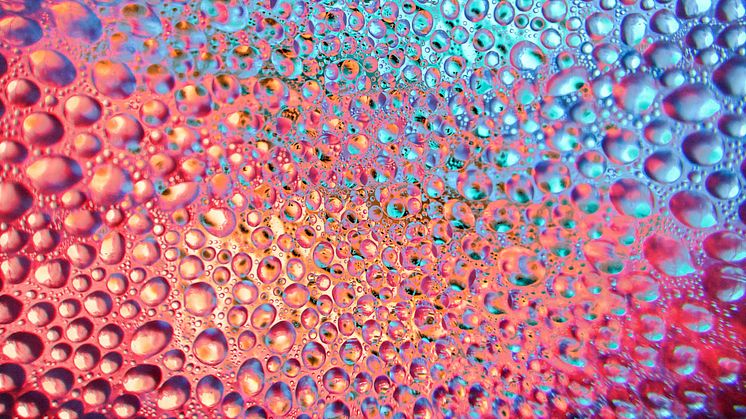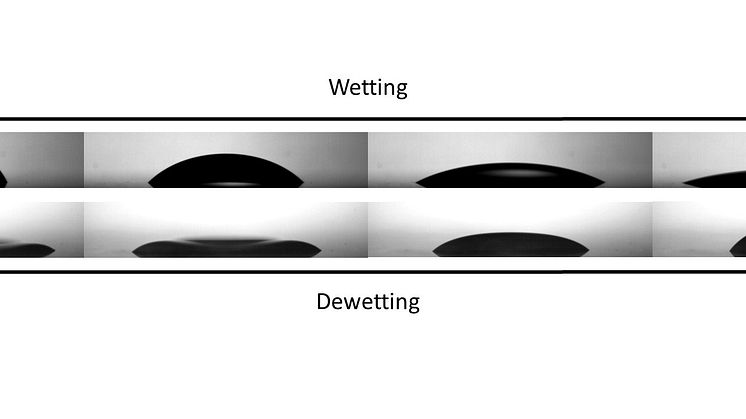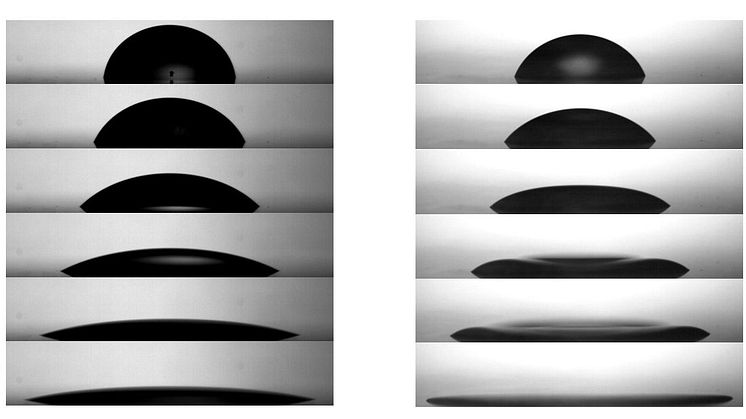
Press release -
It’s delightful, it’s dynamic, it’s dewetting!
How would you like a kitchen surface that cleans itself? Technological advances such as this could be one step closer after a breakthrough by Northumbria University and Nottingham Trent University.
Using experimental techniques, researchers have made the first ever direct observation of the elusive dewetting process, which takes place when a liquid film retracts to form a bead-shaped drop. The achievement could now spark a new line of research and lead to breakthroughs involving the use of liquids, such as better coatings and more effective self-cleaning surfaces.
 Dewetting is the opposite of ‘spreading’, a familiar process which can be observed day to day, such as when a drop of oil is placed on the surface of a pan. The liquid initially has a bead-like shape, and it slowly spreads to form a thin film. The opposite process, called dewetting, occurs when a liquid film retracts from a solid to form a bead-shaped drop, which can be observed when a wet window is left to dry up.
Dewetting is the opposite of ‘spreading’, a familiar process which can be observed day to day, such as when a drop of oil is placed on the surface of a pan. The liquid initially has a bead-like shape, and it slowly spreads to form a thin film. The opposite process, called dewetting, occurs when a liquid film retracts from a solid to form a bead-shaped drop, which can be observed when a wet window is left to dry up.
The details of dewetting are extremely important to any situation involving the removal or drying of a liquid. Despite its apparent simplicity, the direct observation of the full dewetting of a droplet into a single drop had remained elusive and difficult to achieve until Northumbria and Nottingham Trent’s recent experiment.
In a recent paper in the journal Science Advances, the research team came up with an ingenious solution to this problem. Using a novel method known as dielectrowetting, they exploited the electric properties of liquids to force a liquid to coat a solid surface using an applied voltage.
Professor Glen McHale, Pro-Vice Chancellor (Engineering and Environment) at Northumbria University and Professor of Applied and Material Physics, said: “Our experimental setup opens-up the possibility of preparing liquid shapes in a very controlled manner, which then dewet. This can lead to new methods for liquid manipulation in technologies such as coating and self-cleaning surfaces.”
By embedding very thin patterned electrodes in the solid and carefully arranging them into a circular pattern, the team achieved the formation of a thin circular liquid film. By switching off the voltage, they revealed, for the first time, the full dewetting process of the liquid film back to a bead-like drop shape.
Professor Carl Brown, Coordinator of the Nottingham Trent University Engineering Research Unit, and Professor of Physics in the School of Science and Technology, said: “At first sight, one might have expected that dewetting is just the time-reversal of spreading. Surprisingly, we found that dewetting not spreading in reverse. Instead of a smooth sequence of drop-like shapes, the dewetting film forms a rim at its own edge which retracts at constant speed for most of the dewetting process.”

To understand this behaviour, the team used a combination of theory and numerical simulations to rationalise the experiments. Dr Rodrigo Ledesma-Aguilar, from Northumbria, said: “Both the simulations and the theory support that the liquid tends to adopt the closest local equilibrium shape it can during dewetting. This explains the smooth rim shape which survives for most of the process.”
Nottingham Trent University’s Andrew Edwards, first author of the paper, said: “Unveiling the dynamics of a dewetting film in all its detail has been a mind-blowing experience. This is my first original contribution as a PhD student and has allowed me to apply a range of knowledge gained in my first degree as a physicist. It is extremely pleasing to see how our experiments are so well described by the theory and the simulations.”
Dr Michael Newton, Reader in Experimental Physics in the School of Science and Technology at Nottingham Trent University, added: “Our method can be used to learn more about the underlying physics behind other dewetting phenomena such as condensation, evaporation and droplet rebound. These processes are critical for applications such as fog-collection, coating and lubrication. The technique developed can also be used for characterising liquid properties when only small volumes are available.”
Watch a video about the dewetting process here.
The paper is published under an open access arrangement and is freely available through the Science Advances website here. To find out more about studying at Northumbria University sign up to one of our upcoming Open Days on 29 October or 26 November by clicking here.
Related links
Topics
Categories
Northumbria is a research-rich, business-focused, professional university with a global reputation for academic excellence. To find out more about our courses go to www.northumbria.ac.uk
If you have a media enquiry please contact our Media and Communications team at media.communications@northumbria.ac.uk or call 0191 227 4571.














